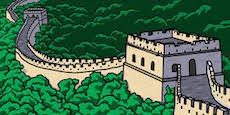There is a famous Chinese poem that contains the line, “he who has never been to the Great Wall is not a true man.” Well, I guess that puts me in the category of a “true man.” I was fortunate to have had the opportunity to visit the Great Wall in 1972. China had been pretty much “closed” to the western world since the 1940s. President Nixon was getting ready for a historic trip to China and some of us were lucky enough to take part in the preparations for that trip.
When I was there, we weren’t left on our own to wander around Peking (it wasn’t called Bejing at the time) and everything had to be requested and arranged through the Diplomatic Service Bureau (DSB.)
We were fairly busy while we were there, but we had requested a trip to the Great Wall and the Ming Tombs and on one of the slower days we were driven out to a section of the Great Wall by a DSB driver. There was no “tour,” we were just allowed to look around and walk on a section of the wall.
Most people usually refer to the wall as The Great Wall of China, but it’s actually known by many names throughout the world. The Great Wall’s original name translated to “The Long Wall of 10,000Li.” I also heard it referred to as “The Earth Dragon” while we were there. It is often called “The Long Wall” and “The Chinese Wall.”

Construction of the wall was started by Emperor Qin Shi Huang, the first emperor of unified China around 220 BC. Previously, China had been divided into numerous geopolitical factions, during which time many walls were constructed to form boundaries between the different groups. When Qin became emperor, the walls between the states were removed and some were repurposed to form a border between China and the “barbarians” to the north. Even though Qin was responsible for starting the wall, the most enduring sections were built during the Ming Dynasty (1368-1644) when Peking was made the new Chinese capital. The Ming wall is still the most famous portion of the structure, with its iconic stone towers and gates.
Construction workers were a disposable commodity when it came to building the wall. It’s estimated that as many as 400,000 people died building the wall, making it known as the “longest cemetery on Earth.” Many of the workers who died during the wall’s construction were buried in its foundation.
Because of the many lives lost during construction of the wall, a farewell tradition of bringing roosters to the wall was begun. It was thought that the rooster’s singing helped carry the souls of those who had lost their lives at the Great Wall. Family members would come to the Great wall to ensure their loved one’s soul was not stuck within the structure by carrying a rooster in hand which helped guide the souls of the lost.
Something we’ve all heard about the Great Wall is that it’s the only man-made structure than can be seen from space with the naked eye. Despite the fact that we’ve heard it for so long, the Great Wall cannot be seen from space — any images of the structure from space were taken with a very zoomed-in camera lens.
The majority of the Great Wall was constructed using earth, brick, wood and stones. Recently, while researching the makeup of the mortar used for building the Great Wall it was found that the standard mixture of lime (limestone that has been heated to a high temperature) and water also contained another ingredient — sticky rice. In tests, scientists compared the quality of mortar made with and without sticky rice and found that sticky rice-lime mortar has more stable physical properties, has greater mechanical strength, and is more cohesive, which makes it a suitable restoration mortar for ancient masonry. Scientists believe that using sticky rice as a construction ingredient was one of the greatest innovations of the Ming dynasty. It helped their structures (including tombs and pagodas) survive earthquakes and the elements.
Over the years, obviously many legends about the wall have developed — one of the best known is the story of “Men Jiangsu’s Bitter Weeping” whose husband died building the wall. Her weeping was so bitter that a section of the wall collapsed, revealing her husband’s bones so she could bury them.
The Great Wall not only served as a military defense system, but also carries a contribution to China’s literary culture, through the sayings and proverbs associated with it. One saying translates to, “If you want to know where the Great Wall is, it’s at the bottom of people’s hearts.” It’s come to mean that if the people make a concerted effort, and their wills unite like the Great Wall, the people will overcome all troubles together. I’d say that’s pretty good advice that we could all use today…..
— 30 —
